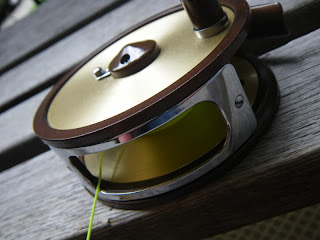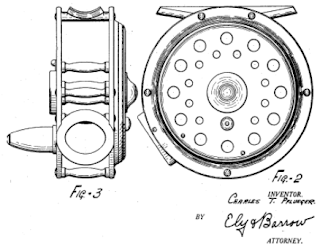 |
| Vintage Fiberglass Browning 322980 |
The Rod
If you have read my blog you know I like fiberglass fly rods....I always have. Per Joe Cornwall's recommendation I have been looking for a Browning Silaflex 322980 for a few years. The 322980 is Joe's favorite smallmouth rod, here is what he had to say about this rod in his article Bulletproof Glass, Fiberglass Fly Rods and the 21st Century:
I have a few other Browning Silaflex rods in my collection and they are fantastic, but the 322980 is a real gem."This 8 foot two-piece rod is designed for a 6 or 7 weight line. It’s efficient with either, but I like it best with the 7 weight. The Browning Silaflex is the rod shown in the photograph with the smallmouth bass at the top of this page, mated to a Pflueger 1495DA and Pat Ehlers Bass Bug taper line.This is a marvelous casting tool, one of the most enjoyable rods I own. It’s ideal for chasing smallmouth and largemouth bass, and has challenged and beat pike of more than 36” and smallmouth up to 23”. It can cast a 1/0 flat-wing streamer or a size 10 Humpy with equal aplomb and fine accuracy out to distances of about 60 feet. I like this rod so much that I’d jump on another one just to have a back up!
The guides on this Silaflex are large enough to accommodate a modern fly line. This is a real problem on some rods. Old glass rods used snake guides that were so small they created tremendous amounts of friction and severely limited casting efficiency. Of course, many of these older rods were designed for silk fly lines, which are much more dense than modern nylon lines. Back then the smaller guides simply weren't a problem!
The one drawback to this rod is the grip. The cork on my example is of outstanding quality, but it was made in a diameter appropriate for someone who can easily palm a basketball. This is easy enough to “fix” with a bit of fine grit sandpaper, however."
I scored this rod on Ebay for more than I wanted to pay, but the rod is in perfect shape and I know I'll have it for a lifetime. I broke my budget rules on this one paying $150 with shipping. Still not bad for a "dream rod."
The Reel
 |
| Shakespeare Speedex Multiplier Reel |
Finding the right reel for my dream setup was more of a chore than the rod. I needed a reel that would properly balance the Silaflex - that took a little digging. My initial choice was the most obvious for a vintage rod, a Pflueger Medalist (1495). The Medalists are the no brainer reel for just about any rod, but I wanted something different for this outfit. Maybe something a little more unique....so I turned to my friends at Fiberglasss Flyrodders for a solution. CrustyBugger replied with a recommendation for a Shakespeare Speedex reel? I immediately thought Shakespeare?....no way! After a little research I knew I was wrong to rule out this reel. Here is what Crusty had to say:
There are many good choices, but for smallmouth, I'd go with a reel with an adjustable drag. I also think you'd be very pleased with a multiplier that will balance nicely with your 322980. Look for a version of the Young 1505 or it's kin like the Shakespeare Speedex (made by Young) or Orvis Magnalite (Young version). I put a Speedex on mine...works great. You can find Speedex's for very little money. You'll spend more for the Young branded 1505's. Be sure to get the narrow spool version for a 7wt line though. It won't hold a 7wt double taper with much backing left so go with a long bellied WF like a RIO Smallmouth line... fantastic smallmouth line.I went with the Speedex and found it on Ebay (new in the box) for $37.50. A great deal for a very nice reel.
 |
| G Loomis Venture |
This is a very handsome reel, don't you think? For the price I don't think you'll find a sharper looking reel.
Here is what Bill and Jestep had to say about the G Loomis Venture:
Bill TrussellJuly 8, 2012 5:18 PMHave you tried the free spool form Gloomis? It picks up the line really fast with just a spin of the reel face.
G loomis discontinued the Venture line. You can still get them on ebay and a few shops have old stock. In my opinion, there is no better reel for the money both in function and aesthetically. I started using the original adventure model about 10 years ago, and that reel still works perfectly. I own all 3 models now for my rods, run a 3wt, a 5wt and the 7 for 8 and 10wt lines.I want to personally thank Bill and Jestep for the recommendations. You guys were spot on about this reel - you'll see it attached to a Fenwick FF756 in the coming months! Thank you.
The Line
 |
| Rio Smallmouth Fly Line |
I ended up settling on the Rio Smallmouth line (7 wt). I know, I know.....I fell for the marketing junk and went with the $75 line "specially made" for smallmouth bass. The decision was based on comments from CrustyBugger and from a blog review posted on Lunker Hunt. Check out the review if you need more information on this line....it is very well done!
Conclusion
I needed another rod like I needed a hole in my head, but that's why I go to work! Someone commented on my blog this week that I didn't know anything about smallmouth bass and that I should just focus my efforts on my 40 hour per week job. He went on to state that my efforts were a waste of time. Maybe this post solidifies his comment, maybe I should quit my job and spend all my waking moments on the water and stop worrying about fly fishing gear.
Whenever you express your opinions about gear, fly shops, fishing spots etc. you always open yourself up to criticism. I hope most of you understand the gear featured and discussed in this post (and everything else on this blog) represents my opinions, experiences etc. I would never claim to be an expert on anything (not even things I do at my dreaded 40 hour per week job!). This setup was purchased largely on the recommendations of others, friends I have met through this blog along the way. All I can say is this setup is exactly what I was looking for and I am very, very happy.
Special thanks to Joe Cornwall (Fly Fish Ohio), CrustyBugger (and all at Fiberglass Flyrodders folks), Bill Trussell, Jestep and Clif G at Lunker Hunt for your help with this setup!


































